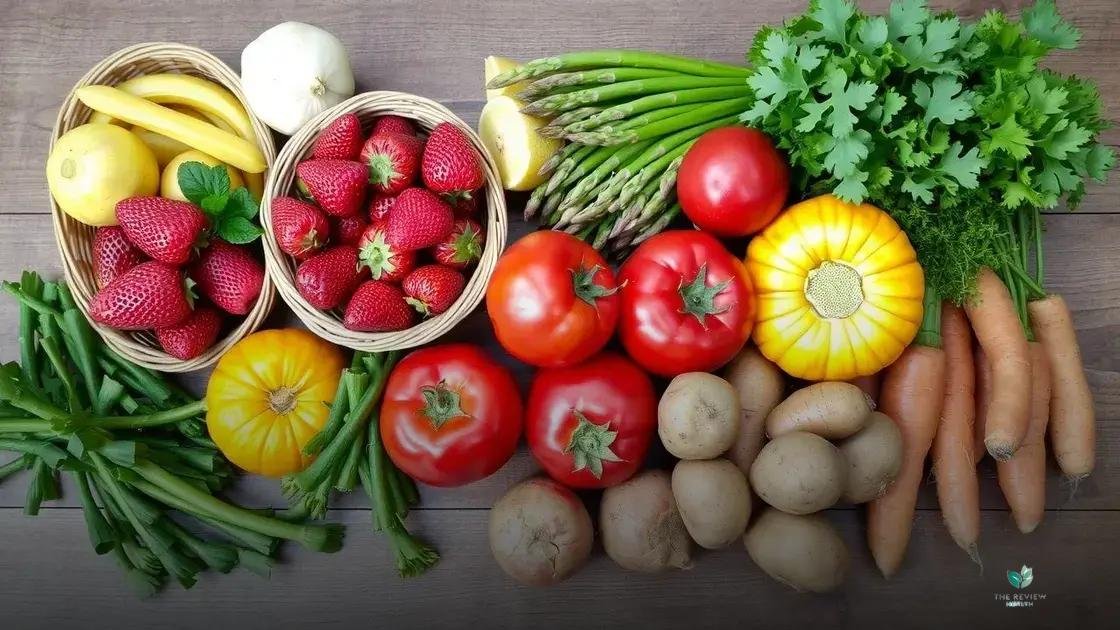Seasonal eating prioritizes consuming fruits, vegetables, and other foods when they are naturally in season in your region, offering peak flavor, higher nutritional value, and environmental benefits.
Seasonal eating brings fresh flavors and health benefits straight to your table. Have you ever considered how much better your meals could taste with ingredients picked at their peak? Let’s dive in!
What is seasonal eating and why does it matter?

Seasonal eating is all about choosing and enjoying fruits, vegetables, and other foods that are naturally in season in your region. This means eating strawberries in the spring, tomatoes in the summer, apples in the fall, and root vegetables in the winter. It’s a simple concept with big implications for your health, the environment, and your taste buds.
Why Does it Matter?
Eating seasonally offers a wealth of benefits. Produce picked at its peak ripeness is packed with flavor and nutrients, often surpassing the taste and nutritional value of out-of-season options that have traveled long distances. Supporting local farmers and reducing food miles also contributes to a more sustainable food system, lessening the environmental impact of transportation and storage. Plus, embracing seasonal eating can introduce you to new foods and exciting flavors, adding variety to your diet.
How to easily find local, seasonal foods

Finding local, seasonal food is easier than you think! Here are a few simple strategies:
1. Visit Your Local Farmers Market:
Farmers markets are a treasure trove of fresh, seasonal produce. Chat with the farmers, learn about their growing practices, and get inspired by the vibrant colors and aromas. Many markets also offer other local goods like honey, cheese, and baked goods.
2. Join a CSA (Community Supported Agriculture):
CSAs connect you directly with local farms. By subscribing, you receive a regular share of the farm’s harvest, delivered to a designated pick-up location. It’s a great way to support local agriculture and enjoy a diverse selection of seasonal produce.
3. Shop at Local Grocery Stores and Co-ops:
Many grocery stores and co-ops now feature sections dedicated to locally sourced produce. Look for signs indicating the origin of the food or ask store staff about their local sourcing practices.
4. Grow Your Own:
Even a small garden or a few pots on a balcony can provide you with fresh, seasonal herbs, vegetables, and fruits. It’s a rewarding experience and a great way to connect with the natural rhythms of the seasons.
5. Use Seasonal Food Guides:
Online resources and seasonal food guides can help you determine what’s in season in your area. These guides often offer recipe ideas and tips for preparing seasonal ingredients.
The health and environmental benefits of eating seasonally

Eating seasonally offers a range of benefits for both your health and the environment.
Health Benefits:
Higher Nutrient Content: Fruits and vegetables picked at their peak ripeness are packed with vitamins, minerals, and antioxidants. These nutrients are essential for maintaining good health and protecting against chronic diseases.
Enhanced Flavor: Seasonally ripe produce simply tastes better! The natural sugars and flavors have fully developed, resulting in a more enjoyable eating experience.
Variety in Your Diet: Following the seasons naturally encourages you to try new fruits and vegetables, expanding your palate and increasing your nutrient intake.
Environmental Benefits:
Reduced Food Miles: Eating locally sourced, seasonal food reduces the distance your food travels from farm to table. This lowers greenhouse gas emissions associated with transportation.
Supports Local Farmers: Buying seasonal produce directly from local farmers supports local economies and sustainable agricultural practices.
Less Pesticide Use: Fruits and vegetables grown in their natural season often require fewer pesticides and herbicides.
Decreased Reliance on Storage and Refrigeration: Eating seasonally reduces the need for long-term storage and refrigeration, further lowering energy consumption.
Embrace the Seasons for a Healthier You and a Healthier Planet
By embracing seasonal eating, you’re not just enjoying delicious, nutrient-rich food, you’re also making a positive impact on the environment and supporting your local community. Start small, explore what’s in season in your area, and savor the flavors of nature’s bounty. It’s a simple change that can make a big difference.
FAQ: Your Questions About Seasonal Eating Answered
What exactly does “seasonal eating” mean?
Seasonal eating means choosing foods that are naturally in season in your region. This typically means they’re grown locally and harvested at their peak ripeness.
Why is eating seasonally better for the environment?
It reduces transportation distances (“food miles”), supports local and sustainable agriculture, and often involves less pesticide use.
Is seasonal eating more expensive?
Not necessarily! Seasonal produce is often cheaper because it’s abundant and doesn’t require long-distance shipping or storage.
How can I find out what’s in season in my area?
Check out local farmers markets, online seasonal food guides, or even ask your local grocer.
What if I can’t find a certain fruit or vegetable I want because it’s out of season?
This is a great opportunity to try something new! Explore other seasonal options and expand your culinary horizons.
How can I incorporate seasonal eating into my busy lifestyle?
Start small! Begin by swapping a few out-of-season items for seasonal alternatives and gradually increase your seasonal choices over time.

Sarah Thompson is a passionate advocate for healthy living and mindful lifestyle choices. With a background in nutrition science and years of experience as a wellness coach, Sarah dedicates her time to exploring the latest trends, research, and products that promote physical, mental, and emotional well-being.
As the lead writer for The Review Health , Sarah combines her expertise with a genuine love for helping others make informed decisions about their health. Her articles are designed to inspire and educate, offering practical tips, honest reviews, and science-backed insights to support readers on their journey to a healthier, happier life.
When she’s not writing or researching, Sarah enjoys yoga, experimenting with plant-based recipes, and spending time outdoors with her family.



